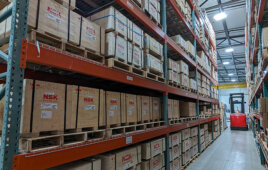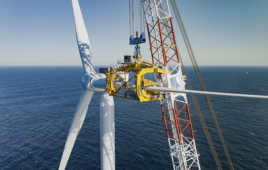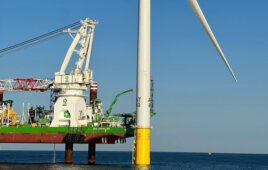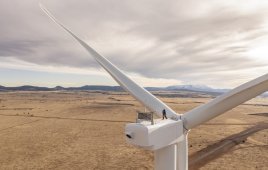By Seren
Direct drive wind turbines account for one-third of all wind power generation. Compared to other wind technologies they have higher energy output and lower maintenance requirements, which means they are favored offshore. To operate direct drive turbines, permanent magnets are needed — and obtaining these magnets is increasingly complicated.
 In spite of wind turbines’ green image, the current methods of producing permanent magnets have unsustainable and potentially dangerous consequences to the planet. However, a European technology firm believes it may have found a solution to these problems. Seren Technologies Limited has developed a technology that recycles permanent magnets. To produce permanent magnets, a resource known as ‘rare earth metals’ is required — and 90% of rare earth metals are supplied by China. But the current state of the market represents a threat to the future of direct drive wind turbines for a number of reasons.
In spite of wind turbines’ green image, the current methods of producing permanent magnets have unsustainable and potentially dangerous consequences to the planet. However, a European technology firm believes it may have found a solution to these problems. Seren Technologies Limited has developed a technology that recycles permanent magnets. To produce permanent magnets, a resource known as ‘rare earth metals’ is required — and 90% of rare earth metals are supplied by China. But the current state of the market represents a threat to the future of direct drive wind turbines for a number of reasons.
Environmental impact
Firstly, the mining practice of rare earth metals creates toxic and radioactive waste almost ton for ton, causing an environment hazard in China and the surrounding region. Environmental regulations are not as strict in China as they are in the United States or Europe, which has, at least for a time, made it possible for China to produce these metals at a much lower cost compared to the rest of the world. In 2015, a news feature from the BBC described heavily polluted lakes at the site of one of China’s main rare earth complexes. Four years on, China is now making concerted efforts to address the environmental impact, but with demand for rare earths from the rest of the world being so high, the country is faced with an enormous challenge. If the environmental impact was not enough of a dilemma for the West’s direct drive wind turbines, then the trade war between the United States and China might well threaten an end of usage altogether.
The U.S.-China trade war
The United States is said to rely on China for 80% of its rare earth imports, prompting the current Trump administration to list the supply as a threat to home security and to introduce trade levies on rare earth exports as a way of leveraging a domestic solution. Approximately one-third of wind turbines globally use direct drive systems, with each turbine holding up to 1 metric-ton (2,200 lbs) of permanent magnets. While some of these magnets are extracted during decommissioning and sold on for reconditioned turbines, at some point they will reach the “waste stream” at the turbine’s end of life.
The precedent so far has been for these magnets to be recycled with ferrous metals, resulting in the rare earth elements being lost and irretrievable. This is depleting the world’s natural resources and further compounding the West’s supply chain controlled by China. Earlier this year, China reduced its exports of rare earth metals causing the price to surge exponentially. And in the current trade war between China and the West, this scenario is likely to repeat soon.
What are rare earth metals?
“Rare earths” is the name given to a group of 17 metals in the periodic table of elements. The name is slightly misleading because they are not actually rare per se; in fact, they are relatively abundant. Their rarity lies in the fact that they are only found in low concentrations in remote parts of the world, such as Inner Mongolia, and are both hazardous and costly to process.
Until recent media coverage of rare earths in the context of the U.S.-China trade negotiations, most people were unaware of the significant role that rare earths play in our modern world. They have made technology lighter, smaller and more powerful than ever before, and are vital components in thousands of technological applications from flat screen televisions, tablets and smartphones to military defense systems such as radar and sonar. It’s no wonder that the current demand for rare earths in the modern world is not being met by the current supply, especially with the complexity of the situation with China.
Without rare earth metals, there would be no permanent magnets for the direct drive wind turbines, and herein lies the current loop that the West finds itself in. But Seren Technologies Limited has made steps toward a more economically and environmentally sustainable pathway as it prepares to commercialize its technology.
A viable means of recycling
The technology created by Seren focuses on the separation of rare earths from each other. The separation is the crucial factor for rare earth elements as their chemical make-ups are very similar. Separating one from another currently requires intensive, inefficient and environmentally damaging processes. Therefore, recycling of rare earths is a limited activity which would otherwise be capable of reducing the world’s dependence on China.
Seren’s new processes provides an efficient, non-hazardous and economically viable means of recycling. Additionally, the processes and technology are applicable to mining rare earths and drastically improve the efficiency of current practices and open new areas for mining. For the wind turbine sector, this is encouraging news, for many of the direct drive wind turbines have an operational lifespan of 20 to 30 years, and this is currently a time when many of these turbines are at risk of decommission. However, with this kind of technology made available by Seren for recycling permanent magnets, there is a new opportunity for the West’s direct drive wind turbine sector to continue, and even thrive sustainably.
Filed Under: Components, Featured, Turbines





Just a small detail, not all the direct drive turbines use rare earth materials.
Interesting article on rare earth materials, Forbes had an article on this topic also years ago on the mining of rare earth material and the total devastation it does to that area, the last paragraph is the most interesting, it said since these are “rare earth materials” and that we will run out of them soon we need to decide where we would like to use them in our I phones, lap tops etc. or in the generation of energy when we have other means/materials to generate energy.
This is an interesting and important article. The Seren website provides a lot of good information about recycling in general.
If we expect to continue our industrial civilization, we must rapidly develop the capacity for recycling the materials we obtain through mining. It would be trivial to say that these virgin sources are finite, and that we are depleting them at an ever-increasing rate. It is too obvious to mention. Except that we simply ignore these facts. We act as though there is an infinite supply of everything.
We throw flashlight batteries into the landfill. That is a lot of stainless steel wasted every day. Chromium and nickel are extremely valuable metals, but we treat them like dirt.
We have produced enough plastic to cover the Earth seven times over with plastic bags. Much of it ends up in the oceans. We cannot remove it. There is now enough plastic in the environment that we are eating about a credit card’s worth every week. We know that the chemicals in plastic are damaging to life, no doubt far worse than most of us can admit, but the scientists know. We recycle almost no plastic.
Better not think about it. We want our industrial civilization to continue. Seren is doing good work. We need more companies like them. Maybe we will be able to survive our insanity for a little while longer than we might have.